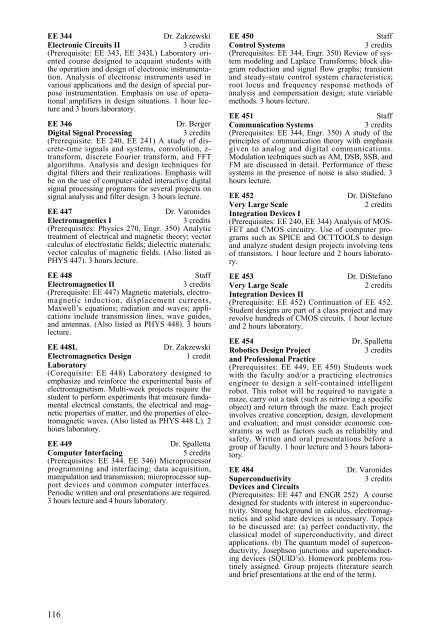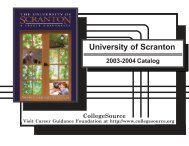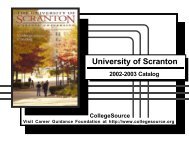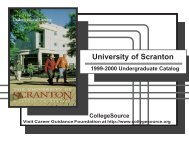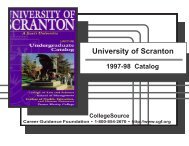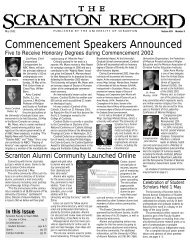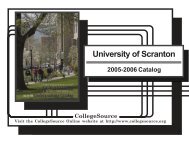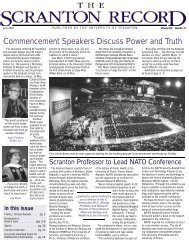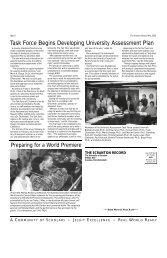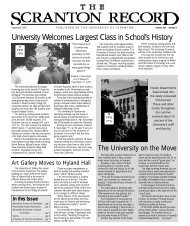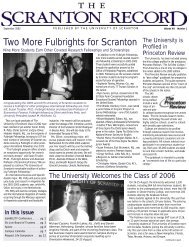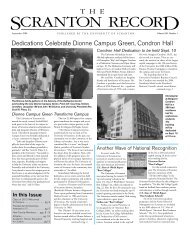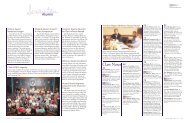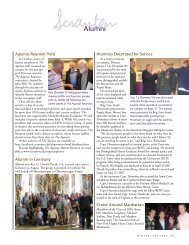Create successful ePaper yourself
Turn your PDF publications into a flip-book with our unique Google optimized e-Paper software.
EE 344 Dr. Zakzewski<br />
Electronic Circuits II 3 credits<br />
(Prerequisite: EE 343, EE 343L) Laboratory oriented<br />
course designed to acquaint students with<br />
the operation and design <strong>of</strong> electronic instrumentation.<br />
Analysis <strong>of</strong> electronic instruments used in<br />
various applications and the design <strong>of</strong> special purpose<br />
instrumentation. Emphasis on use <strong>of</strong> operational<br />
amplifiers in design situations. 1 hour lecture<br />
and 3 hours laboratory.<br />
EE 346 Dr. Berger<br />
Digital Signal Processing 3 credits<br />
(Prerequisite: EE 240, EE 241) A study <strong>of</strong> discrete-time<br />
signals and systems, convolution, ztransform,<br />
discrete Fourier transform, and FFT<br />
algorithms. Analysis and design techniques for<br />
digital filters and their realizations. Emphasis will<br />
be on the use <strong>of</strong> computer-aided interactive digital<br />
signal processing programs for several projects on<br />
signal analysis and filter design. 3 hours lecture.<br />
EE 447 Dr. Varonides<br />
Electromagnetics I 3 credits<br />
(Prerequisites: Physics 270, Engr. 350) Analytic<br />
treatment <strong>of</strong> electrical and magnetic theory; vector<br />
calculus <strong>of</strong> electrostatic fields; dielectric materials;<br />
vector calculus <strong>of</strong> magnetic fields. (Also listed as<br />
PHYS 447). 3 hours lecture.<br />
EE 448 Staff<br />
Electromagnetics II 3 credits<br />
(Prerequisite: EE 447) Magnetic materials, electromagnetic<br />
induction, displacement currents,<br />
Maxwell’s equations; radiation and waves; applications<br />
include transmission lines, wave guides,<br />
and antennas. (Also listed as PHYS 448). 3 hours<br />
lecture.<br />
EE 448L Dr. Zakzewski<br />
Electromagnetics Design 1 credit<br />
Laboratory<br />
(Corequisite: EE 448) Laboratory designed to<br />
emphasize and reinforce the experimental basis <strong>of</strong><br />
electromagnetism. Multi-week projects require the<br />
student to perform experiments that measure fundamental<br />
electrical constants, the electrical and magnetic<br />
properties <strong>of</strong> matter, and the properties <strong>of</strong> electromagnetic<br />
waves. (Also listed as PHYS 448 L). 2<br />
hours laboratory.<br />
EE 449 Dr. Spalletta<br />
Computer Interfacing 5 credits<br />
(Prerequisites: EE 344. EE 346) Microprocessor<br />
programming and interfacing; data acquisition,<br />
manipulation and transmission; microprocessor support<br />
devices and common computer interfaces.<br />
Periodic written and oral presentations are required.<br />
3 hours lecture and 4 hours laboratory.<br />
116<br />
EE 450 Staff<br />
Control Systems 3 credits<br />
(Prerequisites: EE 344, Engr. 350) Review <strong>of</strong> system<br />
modeling and Laplace Transforms; block diagram<br />
reduction and signal flow graphs; transient<br />
and steady-state control system characteristics;<br />
root locus and frequency response methods <strong>of</strong><br />
analysis and compensation design; state variable<br />
methods. 3 hours lecture.<br />
EE 451 Staff<br />
Communication Systems 3 credits<br />
(Prerequisites: EE 344, Engr. 350) A study <strong>of</strong> the<br />
principles <strong>of</strong> communication theory with emphasis<br />
given to analog and digital communications.<br />
Modulation techniques such as AM, DSB, SSB, and<br />
FM are discussed in detail. Performance <strong>of</strong> these<br />
systems in the presence <strong>of</strong> noise is also studied. 3<br />
hours lecture.<br />
EE 452 Dr. DiStefano<br />
Very Large Scale 2 credits<br />
Integration Devices I<br />
(Prerequisites: EE 240, EE 344) Analysis <strong>of</strong> MOS-<br />
FET and CMOS circuitry. Use <strong>of</strong> computer programs<br />
such as SPICE and OCTTOOLS to design<br />
and analyze student design projects involving tens<br />
<strong>of</strong> transistors. 1 hour lecture and 2 hours laboratory.<br />
EE 453 Dr. DiStefano<br />
Very Large Scale 2 credits<br />
Integration Devices II<br />
(Prerequisite: EE 452) Continuation <strong>of</strong> EE 452.<br />
Student designs are part <strong>of</strong> a class project and may<br />
revolve hundreds <strong>of</strong> CMOS circuits. 1 hour lecture<br />
and 2 hours laboratory.<br />
EE 454 Dr. Spalletta<br />
Robotics Design Project 3 credits<br />
and Pr<strong>of</strong>essional Practice<br />
(Prerequisites: EE 449, EE 450) Students work<br />
with the faculty and/or a practicing electronics<br />
engineer to design a self-contained intelligent<br />
robot. This robot will be required to navigate a<br />
maze, carry out a task (such as retrieving a specific<br />
object) and return through the maze. Each project<br />
involves creative conception, design, development<br />
and evaluation; and must consider economic constraints<br />
as well as factors such as reliability and<br />
safety. Written and oral presentations before a<br />
group <strong>of</strong> faculty. 1 hour lecture and 3 hours laboratory.<br />
EE 484 Dr. Varonides<br />
Superconductivity 3 credits<br />
Devices and Circuits<br />
(Prerequisites: EE 447 and ENGR 252) A course<br />
designed for students with interest in superconductivity.<br />
Strong background in calculus, electromagnetics<br />
and solid state devices is necessary. Topics<br />
to be discussed are: (a) perfect conductivity, the<br />
classical model <strong>of</strong> superconductivity, and direct<br />
applications. (b) <strong>The</strong> quantum model <strong>of</strong> superconductivity,<br />
Josephson junctions and superconducting<br />
devices (SQUID’s). Homework problems routinely<br />
assigned. Group projects (literature search<br />
and brief presentations at the end <strong>of</strong> the term).


